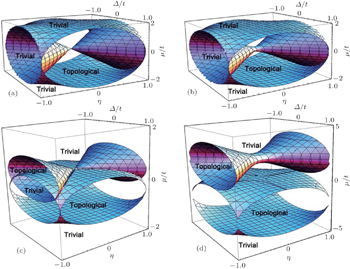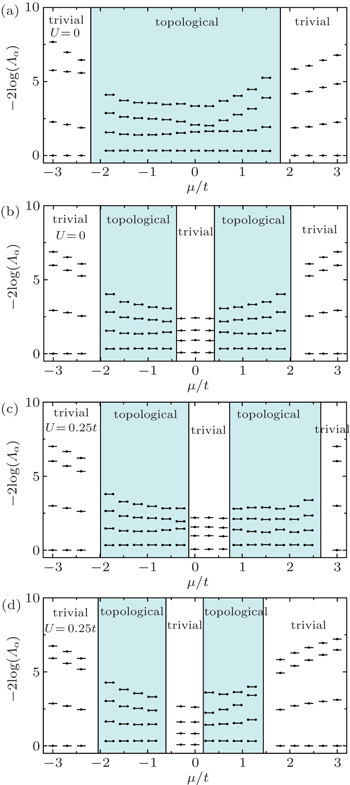† Corresponding author. E-mail:
Project supported by the National Basic Research Program of China (Grant No. 2012CB921704).
We study the effects of the next-nearest-neighbor hopping and nearest-neighbor interactions on topological phases in a one-dimensional generalized Kitaev model. In the noninteracting case, we define a topological number and calculate exactly the phase diagram of the system. With addition of the next-nearest-neighbor hopping, the change of phase boundary between the topological and trivial regions can be described by an effective shift of the chemical potential. In the interacting case, we obtain the entanglement spectrum, the degeneracies of which correspond to the topological edge modes, by using the infinite time-evolving block decimation method. The results show that the interactions change the phase boundary as adding an effective chemical potential which can be explained by the change of the average number of particles.
In recent years, the topological phase,[1–3] which cannot be described by Ginzburg–Landau symmetry breaking paradigm,[4,5] has been in the focus of research in condensed matter physics. Topological phases are usually characterized by the existence of an excitation gap in the bulk and the presence of gapless edge modes. The Kitaev chain,[6] a simple toy model of a one-dimensional (1D) topological superconductor[7–12] which contains a tight-binding chain of spinless electrons and a p-wave superconducting pairing term, is a typical example for the appearance of Majorana zero energy modes with strong Rashba spin–orbit interaction,[13–19] Recently, it has been reported that the Kitaev chain was realized in several nanowire experiments and the Majorana fermions (Majorana zero modes) were found in the nanowire systems.[20–25]
In this paper, we study a dimerization Kitaev chain[26] and focus especially on the effects of the next-nearest-neighbor (NNN) hopping and nearest-neighbor (NN) interactions on this system. In the non-interaction case, we first analyze the symmetry and the topological class[27–30] of the model in the Bogoliubov–de Gennes form.[31] Then we define a topological number and calculate the boundary between the topological and trivial phases. With exact diagonalization on a finite chain, we obtain the zero energy modes and the localization of the corresponding wave function.
In one-dimensional systems, topological phases can be characterized by the entanglement spectrum,[32–34] which can be obtained from the eigenvalues of a reduced density matrix. In the 1D topological superconductor, the degeneracy of the entanglement spectrum corresponds to the gapless edge modes.[33,34] On the matrix product state (MPS) formalism,[35–38] the entanglement spectrum can be calculated effectively by the infinite time-evolving block decimation (iTEBD) method.[39,40] For the dimerization Kitaev chain, we show the 2-fold degeneracy of the entanglement spectrum in the topological region. In the interaction case, we give a brief explanation on the relationship among the change of topological phase boundary, the effective chemical potential and the average particle number of the system.
The paper is organized as follows. In Section 2 we introduce the model and discuss the symmetries and the topological class of the model. To discuss the topological properties of the system, in Section 3 we define a winding number and obtain the phase diagram in the non-interacting case. In Section 4, we first calculate the zero energy modes of a finite chain and give their edge localization. Then we obtain the entanglement spectrum under open boundary conditions with and without interaction respectively. Finally, the results and conclusions are given in Section 5.
We first introduce a Kitaev/Majorana chain with the staggered NN and NNN hopping terms. Its Hamiltonian is given by





In order to analyze the topological properties of the system, we can first study the bulk band structure of the model and then calculate the boundary states of a finite chain. The Hamiltonian (









The energy eigenvalues of the system can be obtained by diagonalizing the Hamiltonian (


For a gapped noninteracting fermion system, the topological class is determined by symmetry and spatial dimension.[28–30] In this spinless fermion system, the time-reversal operator is defined by T = 𝒦, where 𝒦 is the complex-conjugation operator.[28,29] The model has the time-reversal symmetry





For the case of μ = 0, tA = 0, and tB = 0, there is another chiral symmetry operator C′, which is given by

With the symmetries P′, C′, and T, the system also belongs to BDI class. The class with the symmetry P′, C′, and T is associated with zero energy modes of soliton while the class with the symmetry P, C, and T is associated with Majorana zero energy modes.[26]
To discuss the topological properties of the system, we can define a winding number as

For the chiral operator C, we can choose a unitary transformation






With addition of the nonzero NNN hopping, the symmetries P′ and C′ are broken, therefore there are no zero energy modes of soliton and the edge modes are Majorana zero energy modes.[26]
In a finite chain, the energy spectrum of the system can be obtained by diagonalizing the Hamiltonian (
Figure
In order to study the topological properties of the system with the interaction term




With the iTEBD numerical method,[39,40] based on the MPS formalism, the ground state of the system and entanglement spectrum can be effectively calculated.
In order to construct the MPS and employ the iTEBD method, we need to do a Jordan–Wigner transformation under which the Hamiltonian becomes



The entanglement spectrum in the non-interacting case is shown in Figs.
The interaction term reads (after doing a Jordan–Wigner transformation)

With addition of small NN electron–electron interactions, the 2-fold degeneracy of the entanglement spectrum does not disappear, and the phase boundary has changed as illustratively shown in Figs.
Because of 
In this paper, we have studied the effects of the NNN hopping and NN interactions on the topological phases in a one-dimensional dimerization Kitaev model. For the symmetry discussed with Bogoliubov–de Gennes form, the topological class of the model is BDI. By defining a topological number, we obtain the phase diagram of the model without interaction, which shows that the change of phase transformation points which is caused by the NNN hopping can be described by a shift of chemical potential. With the electron–electron NN interactions, the topological phase boundary changes with the addition of an effective chemical potential which can be explained by the change of the average particle number.
| 1 | |
| 2 | |
| 3 | |
| 4 | |
| 5 | |
| 6 | |
| 7 | |
| 8 | |
| 9 | |
| 10 | |
| 11 | |
| 12 | |
| 13 | |
| 14 | |
| 15 | |
| 16 | |
| 17 | |
| 18 | |
| 19 | |
| 20 | |
| 21 | |
| 22 | |
| 23 | |
| 24 | |
| 25 | |
| 26 | |
| 27 | |
| 28 | |
| 29 | |
| 30 | |
| 31 | |
| 32 | |
| 33 | |
| 34 | |
| 35 | |
| 36 | |
| 37 | |
| 38 | |
| 39 | |
| 40 | |
| 41 | |
| 42 | |
| 43 | |
| 44 | |
| 45 |






